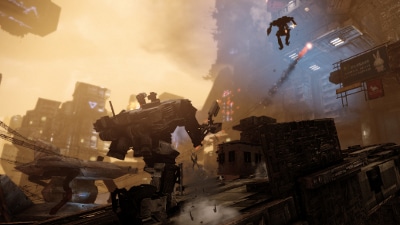
I was at a tradeshow last year watching a Hawken game play demo. One of our tech marketing guys shot the floor out from under his rival with a rocket, causing his opponent to drop through the floor to his death.
I had two thoughts immediately:
- I wish I had that back in the day when I was playing Unreal Tournament;
- OMG, that’s a huge step for gaming.
The first reaction was self-serving. I wanted it because it would make the game more fun for me to play.
The second was more complicated. It’s the result of working in and around PC gaming for almost 25 years. It also speaks directly to GameWorks and the work we do with developers.
But both reactions are common among NVIDIA employees.
Tell us about a moment that changed the way you think about games in the comments section below — or share it on your favorite social media network using the hashtag #GamingMoments
By working with developers through our “The Way It’s Meant To Be Played” program, and adding GameWorks technology, we’re striving to make games better. For 10 years, NVIDIA’s TWIMTBP program has created successful partnerships with developers. The result: a massive body of gaming innovation, thanks to over 300 passionate engineers on staff who eat, sleep and breathe gaming.
GameWorks
 We call the product of their labor GameWorks. It’s a library of advanced gaming technologies that gives developers the best way to realize their vision. Rather than throwing white papers and algorithms at developers, GameWorks takes a production-oriented approach to adding effects to games. It focuses on giving developers a complete middleware solution. This lets them easily integrate and adopt new effects to make games better, faster.
We call the product of their labor GameWorks. It’s a library of advanced gaming technologies that gives developers the best way to realize their vision. Rather than throwing white papers and algorithms at developers, GameWorks takes a production-oriented approach to adding effects to games. It focuses on giving developers a complete middleware solution. This lets them easily integrate and adopt new effects to make games better, faster.
NVIDIA has been the driving force in PC gaming for two decades. We take a lot of pride in being the flag bearer for the PC gaming platform. Our goal is to keep advancing gaming on the PC platform by pushing the visual effects envelope and core gaming experience far beyond any other platform. We then work with developers on cross-platform SDKs, libraries and tools to extend the PC experience to other platforms.
Everyone at NVIDIA believes great content sells hardware. So, in addition to building the best hardware, we invest an enormous amount into making games better. It’s the subtle details in things like hair, cloth, lighting, debris and water that make games more immersive.
These subtle effects have a big impact on the gamer’s “suspension of disbelief.” We create algorithms to improve the details and give them to developers through GameWorks. We then work to integrate support directly into major game engines (CryEngine3, Frostbite, id Tech 5, Source, Unreal Engine 4 and Unity). These engines are the framework around which games are created.
Pushing the Envelope
About five years ago we helped with the realistic cloth in Mirror’s Edge and destructive environments in Warmonger. Those physics effects were groundbreaking at the time. Since then, PhysX support for effects like those has been built in to the Unreal Engine, and the libraries and tools to implement them can be downloaded from our website. We made it easier for developers to add those types of effects to their games and now they are appearing in many games.
GameWorks is a way we can innovate at a faster pace. It’s also a massive R&D investment for NVIDIA. We make that investment because its core to our strategy and how we think about gamers. We don’t want the market to be limited to a generic gaming experience with lowest common denominator technology. We want to offer gamers a better experience. GameWorks is how we help give it to them. We encourage other companies to do the same. We think the competitive dynamic will push gaming forward.
As a gamer, I can say it’s working. I started gaming when some games had little to no physics. A time before we had entire games based on physics, such as Angry Birds and Portal 2. So as that floor fell out from under that mech in Hawken, I looked back at the path games followed to get there.
Total Recall
I remembered driving through dirt on a motorcycle in Road Rash and wondering why it left no tracks. Or learning how to launch myself with a rocket jump in Quake. I remembered when players could destroy only a few objects in a game scene, like the barrels in Doom. I recalled throwing objects with the gravity gun in Half-Life 2. I was reminded of the time my weapon set fire to a field in Far Cry 2.
My mind flashed through “my” history of game physics that culminated with that mech dropping through the floor to its death.
And I thought, “Wow, that’s really hard to do.”
That’s innovation.